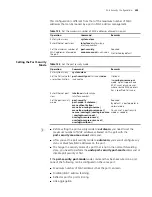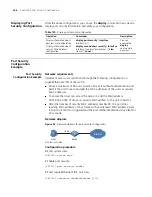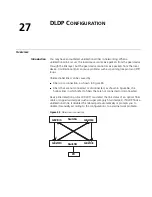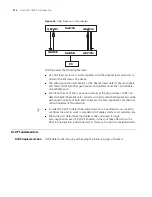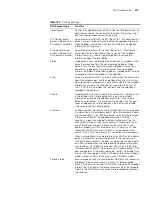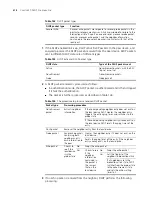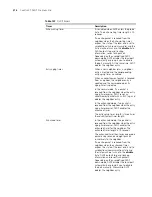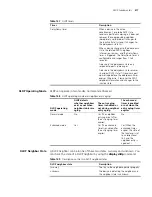
DLDP Fundamentals
217
DLDP Operating Mode
DLDP can operate in two modes: normal and enhanced.
DLDP Neighbor State
A DLDP neighbor can be in one of these two states: two way and unknown. You
can check the state of a DLDP neighbor by using the
display dldp
command.
DelayDown timer
When a device in the active,
advertisement, or probe DLDP state
receives a port down message, it does not
removes the corresponding neighbor
immediately, neither does it changes to
the inactive state. Instead, it changes to
the delaydown state first.
When a device changes to the delaydown
state, the related DLDP neighbor
information remains, and the DelayDown
timer is triggered. The DelayDown timer is
configurable and ranges from 1 to 5
seconds.
A device in the delaydown state only
responds to port up messages.
A device in the delaydown state resumes
its original DLDP state if it receives a port
up message before the delaydown timer
expires. Otherwise, it removes the DLDP
neighbor information and changes to the
inactive state.
Table 147
DLDP timers
Timer Description
Table 148
DLDP operating mode and neighbor entry aging
DLDP operating
mode
DLDP detects
whether neighbors
exist or not when
neighbor tables are
aging
The entry aging
timer is enabled or
not during neighbor
entry aging
The enhanced
timer is enabled
or not when the
entry aging timer
expires
Normal mode
No
Yes (The neighbor
entry ages out after
the entry aging timer
expires)
No
Enhanced mode
Yes
Yes (The enhanced
timer is enabled after
the entry aging timer
expires)
Yes (When the
enhanced timer
expires, the state of
the local end is set
to unidirectional
link, and the
neighbor entry is
aged out.)
Table 149
Description on the two DLDP neighbor states
DLDP neighbor state
Description
two way
The link to the neighbor operates properly.
unknown
The device is detecting the neighbor and
the neighbor state is unknown.
Summary of Contents for Switch 7757
Page 32: ...32 CHAPTER 1 CLI OVERVIEW...
Page 70: ...70 CHAPTER 5 LOGGING IN USING MODEM...
Page 76: ...76 CHAPTER 7 LOGGING IN THROUGH NMS...
Page 86: ...86 CHAPTER 9 CONFIGURATION FILE MANAGEMENT...
Page 120: ...120 CHAPTER 13 ISOLATE USER VLAN CONFIGURATION...
Page 126: ...126 CHAPTER 14 SUPER VLAN...
Page 136: ...136 CHAPTER 16 IP PERFORMANCE CONFIGURATION...
Page 152: ...152 CHAPTER 17 IPX CONFIGURATION...
Page 164: ...164 CHAPTER 19 QINQ CONFIGURATION...
Page 172: ...172 CHAPTER 21 SHARED VLAN CONFIGURATION...
Page 182: ...182 CHAPTER 22 PORT BASIC CONFIGURATION...
Page 198: ...198 CHAPTER 24 PORT ISOLATION CONFIGURATION...
Page 208: ...208 CHAPTER 25 PORT SECURITY CONFIGURATION...
Page 224: ...224 CHAPTER 27 DLDP CONFIGURATION...
Page 232: ...232 CHAPTER 28 MAC ADDRESS TABLE MANAGEMENT...
Page 240: ...240 CHAPTER 29 CENTRALIZED MAC ADDRESS AUTHENTICATION CONFIGURATION...
Page 280: ...280 CHAPTER 30 MSTP CONFIGURATION...
Page 348: ...348 CHAPTER 35 IS IS CONFIGURATION...
Page 408: ...408 CHAPTER 39 802 1X CONFIGURATION...
Page 412: ...412 CHAPTER 40 HABP CONFIGURATION...
Page 422: ...422 CHAPTER 41 MULTICAST OVERVIEW...
Page 426: ...426 CHAPTER 42 GMRP CONFIGURATION...
Page 480: ...480 CHAPTER 47 PIM CONFIGURATION...
Page 506: ...506 CHAPTER 48 MSDP CONFIGURATION...
Page 552: ...552 CHAPTER 51 TRAFFIC ACCOUNTING CONFIGURATION...
Page 570: ...570 CHAPTER 53 HA CONFIGURATION...
Page 582: ...582 CHAPTER 54 ARP CONFIGURATION SwitchA arp protective down recover interval 200...
Page 622: ...622 CHAPTER 58 DHCP RELAY AGENT CONFIGURATION...
Page 684: ...684 CHAPTER 61 QOS CONFIGURATION...
Page 718: ...718 CHAPTER 63 CLUSTER...
Page 738: ...738 CHAPTER 67 UDP HELPER CONFIGURATION...
Page 752: ...752 CHAPTER 69 RMON CONFIGURATION...
Page 772: ...772 CHAPTER 70 NTP CONFIGURATION...
Page 796: ...796 CHAPTER 72 FILE SYSTEM MANAGEMENT...
Page 802: ...802 CHAPTER 73 BIMS CONFIGURATION...
Page 814: ...814 CHAPTER 74 FTP AND TFTP CONFIGURATION...
Page 830: ...830 CHAPTER 75 INFORMATION CENTER...
Page 836: ...836 CHAPTER 76 DNS CONFIGURATION...
Page 852: ...852 CHAPTER 77 BOOTROM AND HOST SOFTWARE LOADING...
Page 858: ...858 CHAPTER 78 BASIC SYSTEM CONFIGURATION DEBUGGING...

